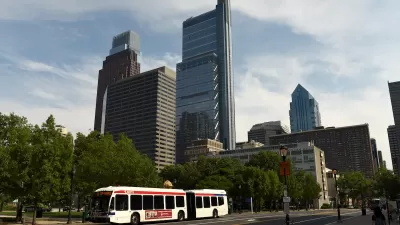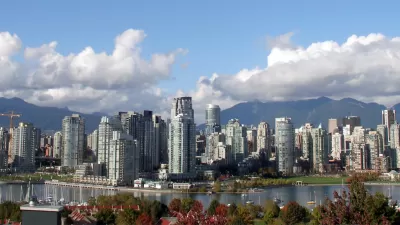Vancouver's ahead-of-the-curve 1997 decision to prioritize active transport, rather than balance its ways of getting around, has affected everything about how the city has been designed since then.
At a book launch party I had the pleasure of attending this past weekend, our host, Simon Fraser University City Program Director Gordon Price, began the evening by asking each member of the crowd to state an urban design decision that “they loved.” It was a fun and provocative question for a group of city-making wonks like us, and an even better icebreaker than the wine.
As you might imagine, each respondent had their own approach to answering the question, which is what made hearing all the excellent responses interesting.
When it came to my turn, my answer took a big picture and perhaps surprising approach, depending on your definition of urban design. In Vancouver, a city often referred to as "a city by design", the most important urban design decision we ever made, the decision I loved most, is actually usually referred to as a transportation decision.
In 1997, the city approved its first influential Transportation Plan.
It was a game-changer for our city-making model in many ways, most notably in its decision to prioritize the ways we get around, rather than balance them. The active, healthy and green ways of getting around were ranked highest - first walking, our top priority, then biking, and then transit, in that order. The prioritization then went on to goods movement for the purposes of business support and economic development, and lastly, the private vehicle.
Vancouver still spends a considerable amount of energy trying to make driving a greener and healthier proposition, with examples from electric vehicle charging station pilot projects, to policies and zoning incentives that have contributed to our incredible growth of car-sharing. However the private vehicle remains the last priority. I always note that we are not anti-car, and we rarely ban the car, but prioritizing it last has a dramatic effect on the way we design our city.
If you’re a driver who is worried about a “war on the car”, remember this - our model of city building understands the “Law of Congestion” and proves that when you build a multimodal city, it makes getting around better and easier for every mode of transportation, including the car. It makes our city work better in every way.
This decision to prioritize rather than balance our ways of getting around has affected everything in how our city has been designed since then. It’s a huge part of the essential DNA that our city has grown from. It’s guided every decision, from thousands of physical design decisions, to our budget allocation. Has every decision followed it perfectly? No - there are many illustrations around the city where the prioritization hasn't been perfectly reflected. However, enough decisions have reflected this prioritization to make our city design fundamentally different.
So my answer to Gordon’s question “what urban design decision do I love?” It’s our ahead-of-the-curve 1997 decision to prioritize active transport rather than trying to balance ways of getting around. A decision we reinforced and are taking further in the recent Transportation Plan Update I had the pleasure of working on.
A transportation decision, sure – but also an urban design decision, a city-making decision. The most important urban design decision our "city by design" ever made, flowing from the most important decision of any type we ever made – saying no to freeways in our city.
As today’s municipal leaders approach some key decisions for our city-building future, such as the opportunity to finally remove the Georgia and Dunsmuir Viaducts (which I call the only Asterisk next to the statement that we have no freeways in Vancouver) and leave a stronger and better connected city in their place, it's critically important that we remember and recognize the power of this urban design decision.

Alabama: Trump Terminates Settlements for Black Communities Harmed By Raw Sewage
Trump deemed the landmark civil rights agreement “illegal DEI and environmental justice policy.”

Study: Maui’s Plan to Convert Vacation Rentals to Long-Term Housing Could Cause Nearly $1 Billion Economic Loss
The plan would reduce visitor accommodation by 25% resulting in 1,900 jobs lost.

Planetizen Federal Action Tracker
A weekly monitor of how Trump’s orders and actions are impacting planners and planning in America.

Wind Energy on the Rise Despite Federal Policy Reversal
The Trump administration is revoking federal support for renewable energy, but demand for new projects continues unabated.

Passengers Flock to Caltrain After Electrification
The new electric trains are running faster and more reliably, leading to strong ridership growth on the Bay Area rail system.

Texas Churches Rally Behind ‘Yes in God’s Back Yard’ Legislation
Religious leaders want the state to reduce zoning regulations to streamline leasing church-owned land to housing developers.
Urban Design for Planners 1: Software Tools
This six-course series explores essential urban design concepts using open source software and equips planners with the tools they need to participate fully in the urban design process.
Planning for Universal Design
Learn the tools for implementing Universal Design in planning regulations.
Caltrans
Smith Gee Studio
Institute for Housing and Urban Development Studies (IHS)
City of Grandview
Harvard GSD Executive Education
Toledo-Lucas County Plan Commissions
Salt Lake City
NYU Wagner Graduate School of Public Service






























